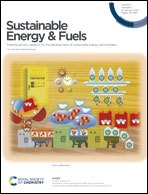Polypyrrole hydrogel as a universal precursor for the target preparation of heteroatom-doped hierarchical carbon with atomically distributed metal sites towards high-efficiency ORR and Zn–air batteries†
Abstract
The development of high-efficiency catalysts for the oxygen reduction reaction (ORR) using Earth-abundant resources is of paramount importance for real applications of renewable energy storage and conversion devices. Herein, we report a simple but universal method for the target preparation of carbon-based electrocatalysts with atomically dispersed metal sites, such as Fe and Mo, in which polypyrrole hydrogel (PP) served as the precursor. Via the spatial isolation of metal species, an Fe-anchored N,P co-doped porous carbon matrix (CPP-900) was developed via the direct pyrolysis of PP crosslinked by cyclotriphosphazene. CPP-900, with concurrently large BET surfaces and hierarchical porosity, was beneficial for the exposure of active sites for the ORR, enhancing the utilization efficiency of catalytic sites and facilitating the mass transport of reactants and products. The incorporation of P and N not only engineered the structure of the carbon matrix but also modified the charge around the Fe center, strengthening the binding interactions between the reactants and catalytic active sites. As a result, CPP-900 presented prominent electrocatalytic activity and selectivity towards the ORR in both alkaline and acidic media. For example, it showed a comparable onset potential (Eonset = 949 mV) and half-wave potential (E1/2 = 848 mV) to those of the commercial Pt/C (962 and 817 mV) in alkaline media. Furthermore, the Zn–air battery (ZAB) catalyzed by CPP-900 displayed a high specific power (204.13 mW cm−2), excellent rate capacity, as well as superior running stability, surpassing those of Pt/C. This work offers an innovative strategy for the targeted preparation of advanced catalysts for the ORR and Zn–air batteries.



 Please wait while we load your content...
Please wait while we load your content...